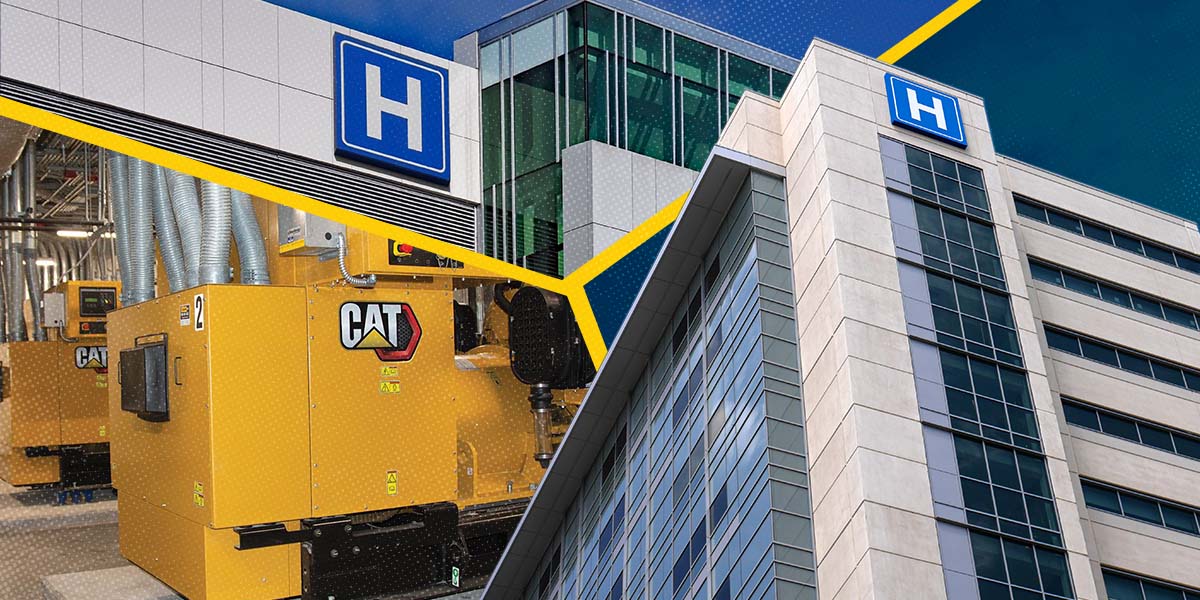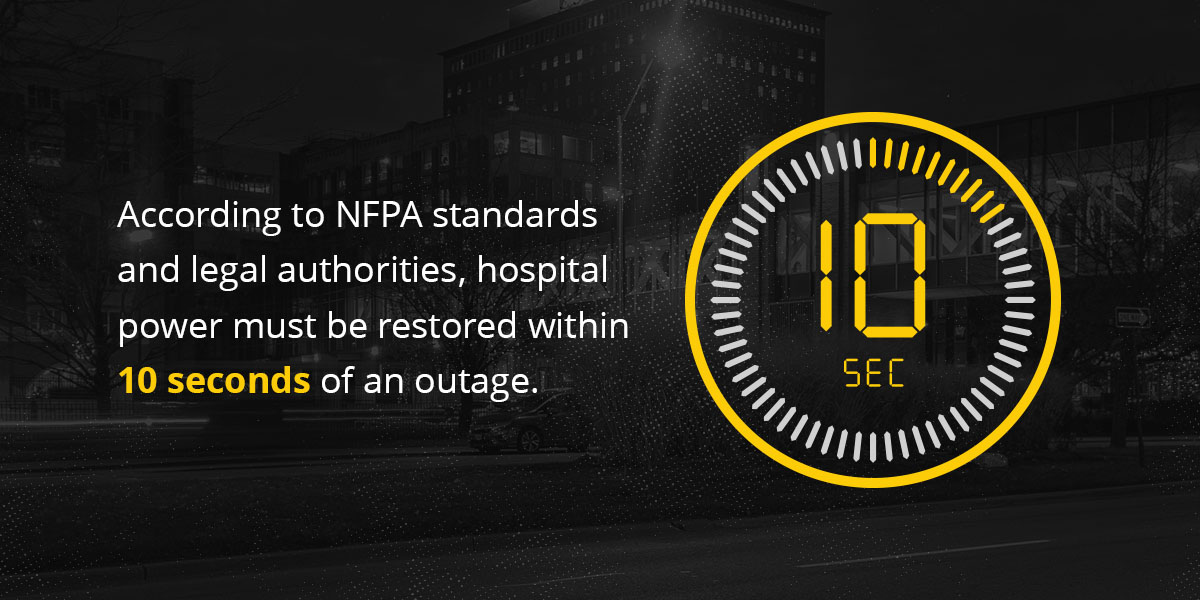

Reliable power delivery is critical for ensuring life-saving hospital operations can continue through emergencies like natural disasters and unplanned outages.
To keep dire situations at bay, regulatory agencies have imposed strict hospital backup generator requirements. Healthcare facilities need to meet specific, stringent standards to ensure continuous operation even in the event of a power outage.
Hospital backup generator requirements cover topics like how quickly the system must power on, how long it needs to provide power, and how rigorous testing and maintenance must be. Let’s look more closely at hospital backup generators and the standards you need to meet if you have one.
Hospitals are responsible for over 10% of energy consumption in the commercial sector, despite taking up less than 5% of its area. Few would argue that this hefty amount of power is unnecessary since it supports essential equipment like life-support systems, bedside alert systems, and the lights that make it possible for surgeons to do their work. It’s easy to imagine the difficulty hospitals would have without power. Even the loss of basic tools, like telephone systems or electronic records systems, can create risk as they interrupt operations and limit communication capabilities.
The severity of a hospital power outage has brought us a range of regulations, primarily from the National Fire Protection Association (NFPA). The Joint Commission (TJC), a healthcare accreditation organization, builds off of these standards and requires hospitals to undergo specific testing and maintenance requirements to achieve regular accreditation.
Although the NFPA standards are widely accepted, the NFPA does not enforce them. This is done by the authority having jurisdiction (AHJ), which varies by locality. While this duty often falls to the fire marshal, other potential authorities include labor departments or health departments.
Hospitals fall under one of the following standards and must abide by its associated regulations:
The Health Care Facilities Code considers generators a part of an essential electrical system (EES), or all of the components of a system designed to supply continuous power to the facility during power disruption. An EES also minimizes the disruption of internal wiring systems.
An organization’s EES falls under one of four different risk categories, with most hospitals falling under Category 1 due to the clear risk to patients in the event of a power outage. The NFPA splits an EES into three branches:
Both life safety and critical branches are wired independently of other equipment with special protections. Power must be restored within 10 seconds of interruption.
Another distinction the NFPA makes is between systems described as Type 1 or 2. The two are similar but vary in their power distribution system. Hospitals have backup generators that are typically a Type 1 EES since they fall under Category 1.
Under NFPA 101: the Life Safety Code, generators — your emergency power supply (EPS) — are considered part of an entire emergency power supply system (EPSS). The entire EPSS encompasses components like transfer switches and load terminals that help deliver power. Like the Category distinctions for NFPA 99, NFPA 110 has Levels 1 and 2. Level 1 refers to systems where a power failure would result in loss of human life or serious injuries, and Level 2 systems have less critical risks.
The type of EPSS you have dictates how long it needs to stay running without refueling. NFPA 99 dictates that a hospital EES be classified as Type 10, Class X, Level 1 under NFPA 110. Class X leaves the decision of fuel capacity up to the AHJ. Typically, they require hospitals to be able to run on generator power from 24 to 96 hours.
Routine testing and preventive maintenance are also critical for keeping generators in good working condition. Some tasks you need to perform include:
Hospitals and medical facilities can choose from several types of generators to keep the building moving:
Here are the most common questions we receive from Thompson Power Systems customers across the healthcare industry.
The main regulatory agencies that set hospital backup generator requirements include multiple U.S.-based and international organizations. Here is a short list of these agencies:
Other regulations may come from your state or local government. Generator service providers like the team at Thompson Power Systems can help you ensure your hospital generator is in good condition and up to code with relevant standards.

According to NFPA standards and legal authorities, hospital power must be restored within 10 seconds of an outage. Regulations on hospitals are typically much stricter for healthcare organizations than in other industries because they directly impact human life.
Type 1 EES systems support Category 1 spaces where operations are critical, while Type 2 EES systems cover lower-risk areas. Type 1 systems must support three branches of power supply:
Type 2 systems only support two branches — life safety and equipment. They are more suitable for spaces with Category 2 or lower operations, such as nursing homes or limited care facilities.
The number of generators required for a hospital varies widely based on its size and the generator. While some facilities choose to meet their power demands with multiple redundant generators, others choose to focus on a smaller number of powerful generators.
Larger hospitals and health networks will naturally need more generators to maintain operations than smaller facilities. Consulting with an experienced professional in the field can help you determine the specific number of generators that would be suitable for your hospital.
The types of generators that are most suitable for hospitals and medical facilities include:
These generators provide enough power to sustain critical operations for extended periods while maintaining high fuel efficiency and reliability. Portable generators are flexible and advantageous for large organizations that may need to focus on powering specific areas during an outage.
Microgrids and renewable energy systems, such as solar panels, are also suitable options for producing, storing, and releasing sustainable energy when needed. Consulting with an expert can help you determine which fuel option is most appropriate for your facilities.
A hospital’s backup generators need to be dependable and supported by professionals. Here at Thompson Power Systems, you get both. With the power of Caterpillar behind our generators, you can expect reliable performance if the power grid goes down. Our hospital backup generators come in an array of styles, all built to operate at peak efficiency and help you meet standards from the NFPA, as well as emissions requirements from the U.S. Environmental Protection Agency (EPA) and the European Union (EU).
We’ve partnered with hospitals throughout Alabama and northern Florida for over 60 years, delivering powerful generators and the support of our skilled team. We can assist with ongoing maintenance, repairs, and access to a wide parts selection. Browse our backup equipment online or reach out to us to learn more.